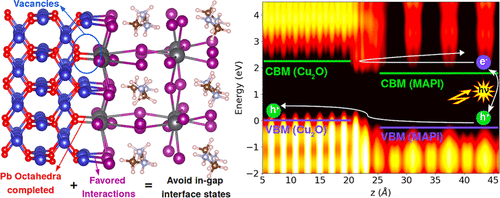当前位置:
X-MOL 学术
›
ACS Appl. Mater. Interfaces
›
论文详情
Our official English website, www.x-mol.net, welcomes your feedback! (Note: you will need to create a separate account there.)
Atomic-Scale Model and Electronic Structure of Cu2O/CH3NH3PbI3 Interfaces in Perovskite Solar Cells.
ACS Applied Materials & Interfaces ( IF 9.5 ) Pub Date : 2020-09-07 , DOI: 10.1021/acsami.0c11187 Jesús E Castellanos-Águila 1, 2 , Lucas Lodeiro 3 , Eduardo Menéndez-Proupin 2 , Ana L Montero-Alejo 4 , Pablo Palacios 5, 6 , José C Conesa 7 , Perla Wahnón 6
ACS Applied Materials & Interfaces ( IF 9.5 ) Pub Date : 2020-09-07 , DOI: 10.1021/acsami.0c11187 Jesús E Castellanos-Águila 1, 2 , Lucas Lodeiro 3 , Eduardo Menéndez-Proupin 2 , Ana L Montero-Alejo 4 , Pablo Palacios 5, 6 , José C Conesa 7 , Perla Wahnón 6
Affiliation

|
Cuprous oxide has been conceived as a potential alternative to traditional organic hole-transport layers in hybrid halide perovskite-based solar cells. Device simulations predict record efficiencies using this semiconductor, but experimental results do not yet show this trend. More detailed knowledge about the Cu2O/perovskite interface is mandatory to improve the photoconversion efficiency. Using density functional theory calculations, here, we study the interfaces of CH3NH3PbI3 with Cu2O to assess their influence on device performance. Several atomistic models of these interfaces are provided for the first time, considering different compositions of the interface atomic planes. The interface electronic properties are discussed on the basis of the optimal theoretical situation, but in connection with the experimental realizations and device simulations. It is shown that the formation of vacancies in the Cu2O terminating planes is essential to eliminate dangling bonds and trap states. The four interface models that fulfill this condition present a band alignment favorable for photovoltaic conversion. Energy of adhesion and charge transfer across the interfaces are also studied. The termination of CH3NH3PbI3 in PbI2 atomic planes seems optimal to maximize the photoconversion efficiency.
中文翻译:

钙钛矿型太阳能电池中Cu2O / CH3NH3PbI3界面的原子尺度模型和电子结构。
在基于混合卤化物钙钛矿的太阳能电池中,氧化亚铜已被认为可以替代传统的有机空穴传输层。器件仿真预测了使用这种半导体的记录效率,但是实验结果尚未显示出这种趋势。为了提高光转换效率,必须具有有关Cu 2 O /钙钛矿界面的更详细的知识。使用密度泛函理论计算,在这里,我们研究CH 3 NH 3 PbI 3与Cu 2的界面O评估它们对设备性能的影响。考虑到界面原子平面的不同组成,首次提供了这些界面的几种原子模型。在最佳理论条件的基础上讨论了界面电子性能,但结合了实验实现和设备仿真。结果表明,Cu 2 O终止平面中空位的形成对于消除悬空键和陷阱态至关重要。满足此条件的四个接口模型呈现出有利于光伏转换的能带对准。还研究了粘附能和跨界面的电荷转移。CH 3 NH 3 PbI 3在PbI中的终止为了使光转换效率最大化,似乎最好是2个原子平面。
更新日期:2020-10-07
中文翻译:

钙钛矿型太阳能电池中Cu2O / CH3NH3PbI3界面的原子尺度模型和电子结构。
在基于混合卤化物钙钛矿的太阳能电池中,氧化亚铜已被认为可以替代传统的有机空穴传输层。器件仿真预测了使用这种半导体的记录效率,但是实验结果尚未显示出这种趋势。为了提高光转换效率,必须具有有关Cu 2 O /钙钛矿界面的更详细的知识。使用密度泛函理论计算,在这里,我们研究CH 3 NH 3 PbI 3与Cu 2的界面O评估它们对设备性能的影响。考虑到界面原子平面的不同组成,首次提供了这些界面的几种原子模型。在最佳理论条件的基础上讨论了界面电子性能,但结合了实验实现和设备仿真。结果表明,Cu 2 O终止平面中空位的形成对于消除悬空键和陷阱态至关重要。满足此条件的四个接口模型呈现出有利于光伏转换的能带对准。还研究了粘附能和跨界面的电荷转移。CH 3 NH 3 PbI 3在PbI中的终止为了使光转换效率最大化,似乎最好是2个原子平面。


























 京公网安备 11010802027423号
京公网安备 11010802027423号